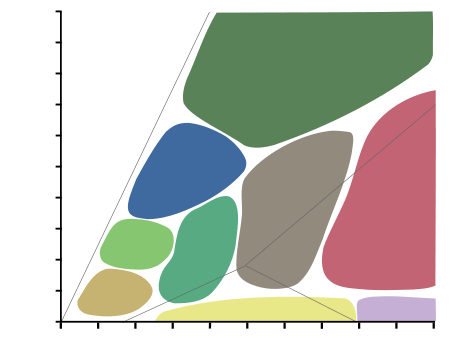Rocks
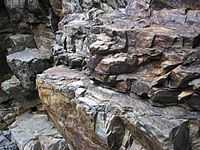
Rocks are a bound aggregate of minerals with usually a large geographic extent.
Occasionally, a rock is composed of only one mineral. But a crystal of the mineral fluorite in your hand is a stone rather than a rock.
Geology
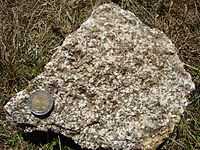
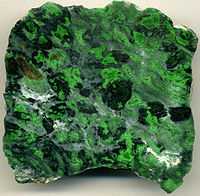
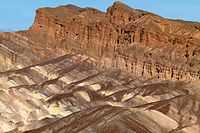
Petrology is a branch of geology that studies rocks, and the conditions in which rocks form. Lithology focuses on macroscopic hand-sample or outcrop-scale description of rocks, while petrography deals with microscopic details. Petrology benefits from mineralogy, optical mineralogy, geochemistry, and geophysics. Three branches of petrology focus on the three major rock types: igneous petrology, metamorphic petrology, and sedimentary petrology.
Minerals
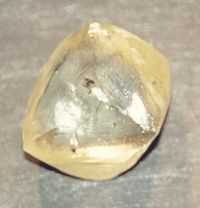
Def. a solid, homogeneous, crystalline chemical element or compound that results from natural inorganic processes is called a mineral.
Mineraloids
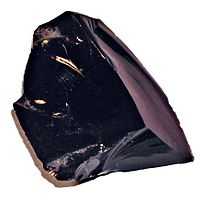
Def. "[a] substance that resembles a mineral but does not exhibit crystallinity"[1] is called a mineraloid.
Def. "[a] small, round, dark glassy object, composed of silicates"[2] is called a tektite.
Def. a naturally occurring, silvery-colored, metallic liquid, composed primarily of the chemical element mercury, is called mercury, or native mercury.
Def. "[a] hard, generally yellow to brown translucent fossil resin"[3] is called an amber.
Def. "[a] flammable liquid ranging in color from clear to very dark brown and black, consisting mainly of hydrocarbons"[4] is called petroleum.
Def. a naturally occurring black glass is called an obsidian.
Def. a naturally occurring, hydrous, "amorphous form of silica, ... [where] 3% to 21% of the total weight is water"[5] is called an opal.
Theory of rocks
"[A] rock is a naturally occurring solid aggregate of one or more minerals or mineraloids."[6]
Def. "[a]ny natural material with a distinctive composition of minerals"[7] is called a rock.
Rocky objects
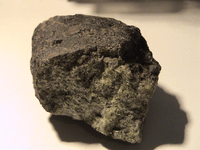
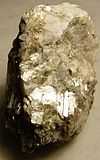
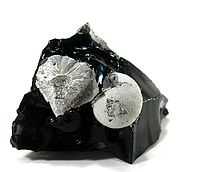

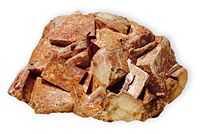
Top right is an image of an olivine rock.
Top left is the mineral mica in a rock.
Second on the right is an image of Cristobalite spheres within obsidian.
Second on the left is an image of a specimen that consists of "porcelainite" - a semivitrified chert- or jasper-like rock composed of cordierite, mullite and tridymite, admixture of corundum, and subordinate K-feldspar.
Third on the right is a feldspar rock.
"Shocked quartz is associated with two high pressure polymorphs of silicon dioxide: coesite and stishovite. These polymorphs have a crystal structure different from standard quartz. Again, this structure can only be formed by intense pressure, but moderate temperatures. High temperatures would anneal the quartz back to its standard form."[8] Stishovite may be formed by an instantaneous over pressure such as by an impact or nuclear explosion type event.[8]
So far several of the polymorphs of α-quartz formed at high temperature and pressure occur with rock types away from meteorite impact craters.
Aeolianites
Def. a "rock formed from dune sand, often calcareous"[9] is called an aeolianite.
Amphibolites
Def. any "of a class of [...] rock composed mainly of amphibole with some quartz etc"[10] is called an amphibolite.
Andesites
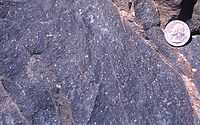
Def. a "class of fine-grained intermediate [..] rock [...] containing mostly plagioclase feldspar"[11] is called an andesite.
"Andesite is a gray to black volcanic rock with between about 52 and 63 weight percent silica (SiO2). Andesites contain crystals composed primarily of plagioclase feldspar and one or more of the minerals pyroxene (clinopyroxene and orthopyroxene) and lesser amounts of hornblende. At the lower end of the silica range, andesite lava may also contain olivine. Andesite magma commonly erupts from stratovolcanoes as thick lava flows, some reaching several km in length. Andesite magma can also generate strong explosive eruptions to form pyroclastic flows and surges and enormous eruption columns. Andesites erupt at temperatures between 900 and 1100° C."[12]
Anorthosites
Def. a "phaneritic, [...] rock characterized by a predominance of plagioclase feldspar"[13] is called an anorthosite.
Anthracites
Def. a "form of carbonized ancient plants; the hardest and cleanest-burning of all the coals; hard coal"[14] is called anthracite.
Def. a coal of a hard variety that contains relatively pure carbon is called an anthracite.
Aphanites
Def. certain "dark [...] rocks having grain so fine that the individual crystals cannot be seen with the naked eye"[15] is called an aphanite.
Aplites
Def. a "fine-grained [...] rock composed mostly of quartz and feldspars"[16] is called an aplite.
Argillites
Def. a "fine-grained [...] rock, intermediate between shale and slate"[17] is called an argillite.
Basanites
Def. a "basaltic [...] rock, similar to chert"[18] is called a basanite.
Basalts

Def. a "hard mafic [...] rock of varied mineral content"[19] is called a basalt.
"Basalt is a hard, black volcanic rock with less than about 52 weight percent silica (SiO2). Because of basalt's low silica content, it has a low viscosity (resistance to flow). Therefore, basaltic lava can flow quickly and easily move > 20 km from a vent. The low viscosity typically allows volcanic gases to escape without generating enormous eruption columns. Basaltic lava fountains and fissure eruptions, however, still form explosive fountains hundreds of meters tall. Common minerals in basalt include olivine, pyroxene, and plagioclase. Basalt is erupted at temperatures between 1100 to 1250° C."[20]
"Basalt is the most common rock type in the Earth's crust (the outer 10 to 50 km). In fact, most of the ocean floor is made of basalt."[20]
"Huge outpourings of lava called "flood basalts" are found on many continents. The Columbia River basalts, erupted 15 to 17 million years ago, cover most of southeastern Washington and regions of adjacent Oregon and Idaho."[20]
"Basaltic magma is commonly produced by direct melting of the Earth's mantle, the region of the Earth below the outer crust. On continents, the mantle begins at depths of 30 to 50 km."[20]
"Shield volcanoes, such as those that make up the Islands of Hawai`i, are composed almost entirely of basalt."[20]
Blueschists
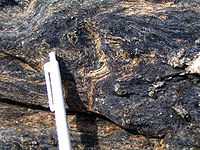
Def. a "rock containing glaucophane"[21] is called a blueschist.
| Diagram showing metamorphic facies in pressure-temperature space. The domain of the graph corresponds to circumstances within the Earth's crust and upper mantle. |
"A metamorphic facies is a set of metamorphic mineral assemblages that were formed under similar pressures and temperatures.[22] The assemblage is typical of what is formed in conditions corresponding to an area on the two dimensional graph of temperature vs. pressure (See diagram at right).[22] Rocks which contain certain minerals can therefore be linked to certain tectonic settings, times and places in geological history of the area.[22] The boundaries between facies (and corresponding areas on the temperature v. pressure graph), are wide, because they are gradational and approximate.[22] The area on the graph corresponding to rock formation at the lowest values of temperature and pressure, is the range of formation of sedimentary rocks, as opposed to metamorphic rocks, in a process called diagenesis.[22]"[23]
"Blueschist is a metavolcanic rock that forms by the metamorphism of basalt and rocks with similar composition at high pressures and low temperatures, approximately corresponding to a depth of 15 to 30 kilometers and 200 to ~500 degrees Celsius. The blue color of the rock comes from the presence of the mineral glaucophane. Blueschists are typically found within orogenic belts as terranes of lithology in faulted contact with greenschist or rarely eclogite facies rocks. ... Blueschist, as a rock type, is defined by the presence of the minerals glaucophane + ( lawsonite or epidote ) +/- jadeite +/- albite or chlorite +/- garnet +/- muscovite in a rock of roughly basaltic composition. Blueschist often has a lepidoblastic, nematoblastic or schistose rock microstructure defined primarily by chlorite, phengitic white mica, glaucophane, and other minerals with an elongate or platy shape. Grain size is rarely coarse, as mineral growth is retarded by the swiftness of the rock's metamorphic trajectory and perhaps more importantly, the low temperatures of metamorphism and in many cases the anhydrous state of the basalts. However, coarse varieties do occur. Blueschists may appear blue, black, gray, or blue-green in outcrop."[24]
Biofacies
Def. a "body of rock with characteristic biological features, such as certain kinds of fossil"[25] is called a biofacies.
Calcarenites
Def. a "form of limestone (or dolomite) composed of sand sized grains derived from the erosion of older rocks"[26] is called a calcarenite.
Carbonatites
Def. any "rock having a majority of carbonate minerals"[27] is called a carbonatite.
Cinerites
Def. a "rock composed mostly of [...] ash"[28] is called a cinerite.
Claystones
Def. a "rock composed of fine, clay particles"[29] is called a claystone.
Coals
Def. a "black rock formed from prehistoric plant remains, composed largely of carbon and burned as a fuel"[30] is called a coal.
Def. a black coal having a relatively high volatile content is called a bituminous coal.
Conglomerates
Def. a "rock consisting of gravel or pebbles embedded in a matrix"[31] is called a conglomerate.
Dacites
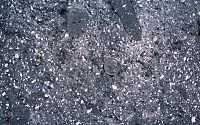
Def. a "rock with a high iron content"[32] is called a dacite.
"Dacite lava is most often light gray, but can be dark gray to black. Dacite lava consists of about 63 to 68 percent silica (SiO2). Common minerals include plagioclase feldspar, pyroxene, and amphibole. Dacite generally erupts at temperatures between 800 and 1000°C. It is one of the most common rock types associated with enormous Plinian-style eruptions. When relatively gas-poor dacite erupts onto a volcano's surface, it typically forms thick rounded lava flow in the shape of a dome."[33]
"Even though it contains less silica than rhyolite, dacite can be even more viscous (resistant to flow) and just as dangerous as rhyolites. These characteristics are a result of the high crystal content of many dacites, within a relatively high-silica melt matrix. Dacite was erupted from Mount St. Helens 1980-86, Mount Pinatubo in 1991, and Mount Unzen 1991-1996."[33]
Diabases
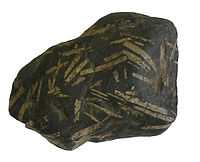
Def. a "fine-grained [...] rock composed mostly of pyroxene and feldspar"[34] is called a diabase.
On the right is an image of a rock, a diabase with an aphanitic groundmass and plagioclase phenocrysts.
Diamictites
Def. "nonsorted, noncalcareous terrigenous deposits composed of sand and/or larger particles dispersed through a muddy matrix"[35] are called diamictons.
Def. a lithified diamicton is called a diamictite.[35]
"Such rocks have in common a mixed, ill-sorted, disperse-megaclastic lithology with a great to extreme range of size grades."[35] The definitions of these rocks are "without regard to origin".[35]
Diorites
Def. a speckled, coarse-grained rock consisting essentially of plagioclase, feldspar, and hornblende or other mafic minerals is called a diorite.
Def. a "grey [...] rock composed mostly of plagioclase feldspar, biotite, hornblende and/or pyroxene"[36] is called a diorite.
Dolerites
Def. a "fine-grained basaltic rock"[37] is called a dolerite.
Dolomites
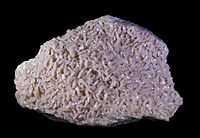
Def. a "saline evaporite consisting of a mixed calcium and magnesium carbonate, with the chemical formula CaMg(CO3)2;"[38] is called a dolomite.
Dolostones
Def. a "carbonate rock that contains a high percentage of the mineral dolomite"[39] is called a dolostone.
Eclogites
Def. a "coarse-grained [...] rock, a mixture of pyroxene, quartz, and feldspar with inclusions of red garnet"[40] is called an eclogite.
Eucrites
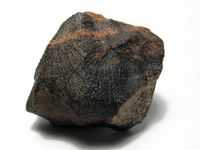
Def. an "achondritic meteoritic rock consisting chiefly of pigeonite and anorthite"[41] is called a eucrite.
Eurites
Def. a "compact feldspathic rock"[42] is called a eurite.
Felsites
Def. a "fine grained [...] rock, generally light in color, composed of felsic minerals"[43] is called a felsite.
Gabbros
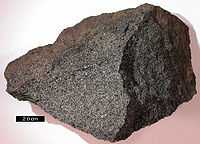
Def. a dark, coarse-grained plutonic rock of crystalline texture, consisting mainly of pyroxene, plagioclase feldspar, and often olivine is called a gabbro.
Def. "a coarsely crystalline, igneous rock consisting of lamellar pyroxene and labradorite"[44] is called a gabbro.
As with diamictites, rock definitions should be without regard to origin.
Gneisses
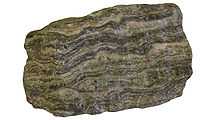
Def. a "rock having bands or veins, but not schistose"[45] is called a gneiss.
Granites
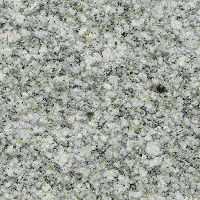

Def. a very hard, granular, crystalline, rock consisting mainly of quartz, mica, and feldspar is called a granite.
Granodiorites
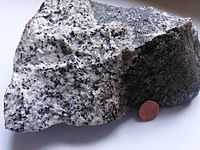
Def. a "rock similar to granite, but containing more plagioclase than potassium feldspar"[46] is called a granodiorite.
Granulites
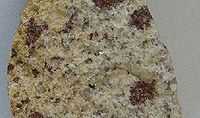
Def. "fine-grained [...] rock composed chiefly of feldspar, quartz, and garnets"[47] is called a granulite.
Greisens
Def. a "highly altered granitic rock containing quartz and mica"[48] is called a greisen.
Greywackes
Def. a "hard dark sandstone with poorly sorted angular grains of quartz, feldspar, and small rock fragments in a compact, clay-fine matrix"[49] is called a greywacke.
Hawaiites
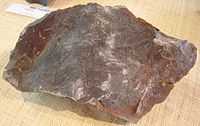
Def. an "olivine basalt intermediate between alkali olivine and mugearite"[50] is called a hawaiite.
Hornfels
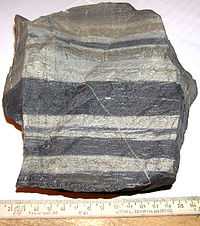
The hornfels shown on the right were formed from the heating of sandstones and siltstones by the Insskoy series of granite intrusions.
Hyaloclastites
Def. a "rock containing glassy fragments"[51] is called a hyaloclastite.
Jets
Def. a "hard, black form of coal"[52], specifically lignite is called a jet.
Kimberlites
Def. a "variety of peridotite containing a high proportion of carbon dioxide; often contains diamonds"[53] is called a kimberlite.
Lamproites
Def. any "of several volcanic rocks having a high potassium content"[54] is called a lamproite.
Lamprophyres
Def. an "uncommon, small-volume ultrapotassic igneous rock primarily occurring as dikes, lopoliths, laccoliths, stocks and small intrusions"[55] is called a lamprophyre.
Lignites

Def. a "low-grade, brownish-black coal"[56] is called a lignite.
Limestones
Def. a rock "primarily composed of calcite (CaCO₃); it occurs in a variety of forms, both crystalline and amorphous"[57] is called a limestone.
Lithosomes
Def. a "uniform mass of rock that has different lithography to that of the surrounding rock"[58] is called a lithosome.
Mafics
Def. "rocks, which contain relatively high concentrations of magnesium and iron"[59] are called mafics.
Marbles
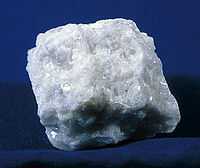
On the right is a block of white marble.
The left shows Mississippian marble in Big Cottonwood Canyon, Wasatch Mountains, Utah.
Monzogranites
Rochovce granite, composing the coring on the right, is a coarse-grained biotite monzogranite.
Monzonites
Def. an "intrusive igneous rock composed mostly of plagioclase and orthoclase"[60] is called a monzonite.
Mugearites
Def. a "kind of orthoclase-bearing basalt that is made up of olivine, apatite, and opaque oxides"[61] is called a mugearite.
Peridotites
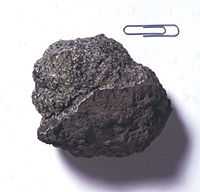
Def. a "rock consisting of small crystals of olivine, pyroxene and hornblende"[62] is called a peridotite.
Phyllites
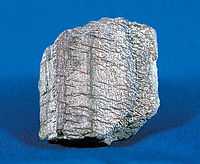
A sample of a phyllite is on the right.
Quartzites
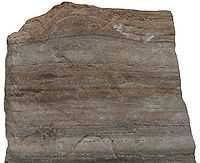
Def. "a [...] rock consisting of interlocking grains of quartz"[63] is called a quartzite.
In a quartzite, fractures occur through the quartz grains. In a sedimentary rock composed of quartz grains, the rock fractures around the quartz grains.
Rhyolites
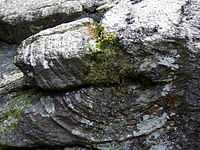
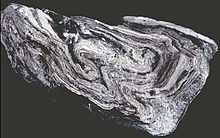
Def. a rock "of felsic composition, with aphanitic to porphyritic texture"[64] is called a rhyolite.
"Rhyolite is a light-colored rock with silica (SiO2) content greater than about 68 weight percent. Sodium and potassium oxides both can reach about 5 weight percent. Common mineral types include quartz, feldspar and biotite and are often found in a glassy matrix. Rhyolite is erupted at temperatures of 700 to 850° C."[65]
"Rhyolite can look very different, depending on how it erupts. Explosive eruptions of rhyolite create pumice, which is white and full of bubbles. Effusive eruptions of rhyolite often produce obsidian, which is bubble-free and black."[65]
"Some of the United States' largest and most active calderas formed during eruption of rhyolitic magmas (for example, Yellowstone in Wyoming, Long Valley in California and Valles in New Mexico)."[65]
"Rhyolite often erupts explosively because its high silica content results in extremely high viscosity (resistance to flow), which hinders degassing. When bubbles form, they can cause the magma to explode, fragmenting the rock into pumice and tiny particles of volcanic ash."[65]
Saprolites
Def. "a chemically weathered rock "[66] is called a saprolite.
Schists
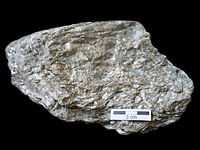
At right is an image of schist.
Shales

Def. a "fine-grained [...] rock of a thin, laminated, and often friable, structure"[67] is called a shale.
Slates
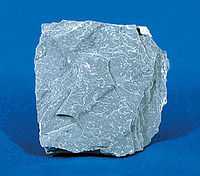
Def. a "fine-grained homogeneous [...] rock composed of clay or [...] ash which [...] cleaves easily into thin layers"[68] is called a slate.
Stocks
Def. a "pipe (vertical cylinder of ore)"[69] is called a stock.
Syenites

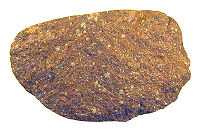
Def. an "igneous rock composed of feldspar and hornblende"[70] is called a syenite.
On the left is a leucocratic variety of nepheline syenite from Sweden called särnaite.
Tonalites
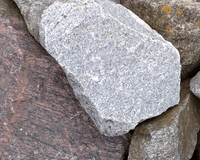
Def. an "igneous, plutonic rock composed mainly of plagioclase"[71] is called a tonalite.
Travertines
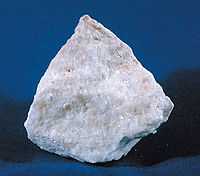
Def. "light, porous form of concretionary limestone (or calcite)"[72] is called a travertine.
Troctolites
Def. an "ultramafic [...] rock, consisting primarily of olivine and calcic plagioclase"[73] is called a troctolite.
Ultramafics
Def. "rocks that contain magnesium and iron and only a very small amount of silica"[74] are called ultramafics.
Liquid objects

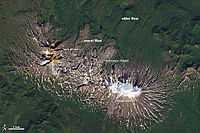
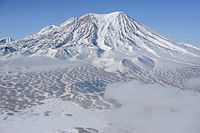
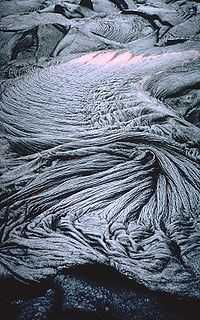
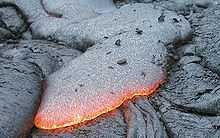
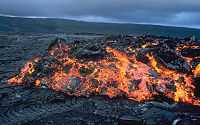
Def. "melted rock ejected by a volcano from its crater or fissured sides"[75] is called a lava.
Usage notes
"Geologists make a distinction between magma (molten rock underground) and lava (molten rock on the surface)."[75]
Def. "molten matter within the earth, the source of the material of lava flows, dikes of eruptive rocks, etc"[76] is called a magma.
"Streams of molten rock that ooze from gaps or vents in the Earth’s surface are called lava flows. Though generally slow-moving, these rivers of rock pose a hazard to everything in their paths. They can bury or burn homes and roads, ruin farmland for generations, and transform glaciers into muddy landslides (lahars)."[77]
"Lava flows can take many shapes and move at very different rates depending on the viscosity of the magma, the slope of the land, and the rate of an eruption. Some of the speediest flows travel 60 kilometers (40 miles) per hour; the slowest creep along at less than 1 kilometer (0.6 miles) per hour. They can sometimes even flow for more than a year after an eruption has ended."[77]
"While viscous lava flows are defined by steep flow fronts and pressure ridges, low-viscosity lavas tend to move faster and create longer, narrower shapes. They also tend to have smaller flow fronts and levee-like structure along their edges. Many characteristics of a low-viscosity lava flow are visible in [the image on the right second down] of Zhupanovsky and Dzenzursky volcanoes on Russia’s Kamchatka Peninsula. The image was acquired by the Operational Land Imager (OLI) on the Landsat 8 satellite on September 9, 2013."[78]
"In the image, younger lava flows appear grey, while older flows are covered by green vegetation. The exact ages of the flows are unclear, but the eruptions that produced them likely occurred during the past few thousand years. Distinctive lava levees are visible along the edges of many of the younger flows. These features form as lava cools and hardens along the edges or top of a flow while the center of a flow still advances."[78]
"In comparison to the Chao dacite in Chile (the product of viscous lava), the flows at Zhupanovsky [at lowest right] and Dzenzursky are much narrower and longer. They have smaller flow fronts (10 to 30 meters tall) in comparison to the sheer 400-meter cliffs at Chao, as well as more prominent lava levees along the edges. Like Chao, the flows shown above have pressure ridges caused by the compression of the cooling top of the lava as the flow advanced."[78]
Def. a "form of lava flow of basaltic rock, usually dark-colored with a smooth or ropey surface"[79] is called pahoehoe.
"Ropy pahoehoe [shown in the fourth image down on the right, taken 11 June 1995] is the most common surface texture of pahoehoe flows. The numerous folds and wrinkles ("ropes") that are characteristic of ropy pahoehoe form when the thin, partially solidified crust of a flow is slowed or halted (for example, if the crust encounters an obstruction or slower-moving crust). Because lava beneath the crust continues to move forward, it tends to drag the crust along. The crust then behaves like an accordian that is squeezed together--the crust is flexible enough to develop wrinkles or a series of small ridges and troughs as it is compressed and driven forward."[80]
Def. a "form of lava flow [shown on the right, fifth image down] consisting of basaltic rock, usually dark-colored with a jagged and loose, clinkery surface"[81] is called an aa.
"`A`a (pronounced "ah-ah") is a Hawaiian term for lava flows that have a rough rubbly surface composed of broken lava blocks called clinkers. The incredibly spiny surface of a solidified `a`a flow makes walking very difficult and slow. The clinkery surface actually covers a massive dense core, which is the most active part of the flow. As pasty lava in the core travels downslope, the clinkers are carried along at the surface. At the leading edge of an `a`a flow, however, these cooled fragments tumble down the steep front and are buried by the advancing flow. This produces a layer of lava fragments both at the bottom and top of an `a`a flow."[82]
Geography
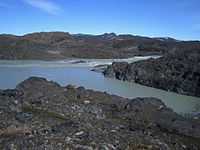
Def. an "outcrop or region with soil and rock dominated by [any] of several green/brown minerals consisting of a magnesium and iron silicates"[83] is called serpentine.
"A critical building block for creating the first life on Earth was found in 3.8-billion-year-old rocks from Isua, Greenland, [...] For the first time, rich concentrations of the element boron have been found in Isua's ancient marine rocks [...] The discovery signals that boron was circulating in seawater and was absorbed by marine clays, which eventually became tourmaline [...] Boron can stabilize ribose, one of three key components of RNA. Ribose, an organic sugar molecule, has a short half-life and naturally decomposes without a stabilizer. [...] Until now, theories for the origin of RNA life pointed to RNA-based chemicals arriving on Earth from Mars. That's because Earth's first rocks and oceans seemed devoid of boron, which takes the form of borate minerals on Earth. On Mars, clays with boron and another RNA stabilizer, molybdenum, are abundant."[84]
"I want to challenge this idea that the early ocean was borate free. The early ocean already contained borate, and therefore, early Earth — not Mars — could provide environments to stabilize ribose."[85]
"The Isua rocks are among the oldest pieces of crust still around from Earth's earliest eons. The layers were deposited under a liquid water ocean, perhaps when life was first emerging. After billion of years of continental smashups, the rocks have been heated, faulted and folded, [...] Some of the rocks were seafloor sediments, such as mud and chert, and others were lavas erupted from underwater volcanic vents, such as pillow basalts. [The] boron in tiny tourmaline crystals trapped inside garnets in the ancient seafloor sediments. The garnets and tourmalines formed after the sediments were deposited, when the rocks were metamorphosed. Boron is one of the major elements of tourmaline. Isua's volcanic rocks also carry boron-rich tourmalines [...] Hydrothermal fluids circulating in the rocks are the likely source of the boron [...] Boron has two isotopes (elements with different numbers of neutrons in their nuclei). The boron isotope ratio in Isua's volcanic rocks also suggests early oceans carried enough boron to support RNA-based life".[84]
"There could have been a role for boron in the stabilizing of ribose in the RNA origin of life. [...] boron-rich seawater [has been] cycling through the Isua volcanic rocks, despite a lack of continental crust. The tourmaline formed in an environment resembling today's deep-sea hydrothermal vents, where superheated seawater and other fluids spew from volcanic fractures. The abundant tourmalines indicate the fluids circulating through the ancient rocks were rich in boron. There is no convincing evidence of seawater boron concentrations being lower at 3.8 billion years ago than at the present."[86]
Entities
"The dominant clast size is highly variable and dependent on the source rock in the Uinta Mountain Group. Cobbles and boulders of sandstone and orthoquartzite of the Uinta Mountain Group are the dominant clasts in glacial diamicton in the southern Uinta Mountains except in the Log Hollow and Blind Stream basins [...], where cobbles of Paleozoic sedimentary rocks are dominant."[87]
Dominant size is a synonym for dominant group.
Metamorphism
Def. any "process by which rocks are changed into other forms"[88] is called metamorphism.
Burial "means that the ambient pressure on the rock increases – as does the temperature. This encourages metamorphism."[89]
Def. any "form of metamorphism that occurs near the Earth's surface"[90] is called katamorphism.
Research
Hypothesis:
- Variations in rocks from one mineral composition into another can occur with each rock type.
Control groups

The findings demonstrate a statistically systematic change from the status quo or the control group.
“In the design of experiments, treatments [or special properties or characteristics] are applied to [or observed in] experimental units in the treatment group(s).[91] In comparative experiments, members of the complementary group, the control group, receive either no treatment or a standard treatment.[92]"[93]
Proof of concept
Def. a “short and/or incomplete realization of a certain method or idea to demonstrate its feasibility"[94] is called a proof of concept.
Def. evidence that demonstrates that a concept is possible is called proof of concept.
The proof-of-concept structure consists of
- background,
- procedures,
- findings, and
- interpretation.[95]
See also
References
- ↑ "mineraloid, In: Wiktionary". San Francisco, California: Wikimedia Foundation, Inc. April 20, 2011. Retrieved 2012-10-23.
- ↑ "tektite, In: Wiktionary". San Francisco, California: Wikimedia Foundation, Inc. August 31, 2012. Retrieved 2012-10-23.
- ↑ "amber, In: Wiktionary". San Francisco, California: Wikimedia Foundation, Inc. October 18, 2012. Retrieved 2012-10-23.
- ↑ "petroleum, In: Wiktionary". San Francisco, California: Wikimedia Foundation, Inc. August 10, 2012. Retrieved 2012-10-23.
- ↑ "Opal, In: Wikipedia". San Francisco, California: Wikimedia Foundation, Inc. October 19, 2012. Retrieved 2012-10-23.
- ↑ "Rock (geology), In: Wikipedia". San Francisco, California: Wikimedia Foundation, Inc. September 27, 2012. Retrieved 2012-10-23.
- ↑ "rock, In: Wiktionary". San Francisco, California: Wikimedia Foundation, Inc. October 23, 2012. Retrieved 2012-10-23.
- 1 2 "Shocked quartz, In: Wikipedia". San Francisco, California: Wikimedia Foundation, Inc. May 14, 2012. Retrieved 2012-10-23.
- ↑ "aeolianite, In: Wiktionary". San Francisco, California: Wikimedia Foundation, Inc. 28 May 2014. Retrieved 2014-12-06.
- ↑ "amphibolite, In: Wiktionary". San Francisco, California: Wikimedia Foundation, Inc. 16 June 2013. Retrieved 2015-02-09.
- ↑ "andesite, In: Wiktionary". San Francisco, California: Wikimedia Foundation, Inc. 26 April 2014. Retrieved 2015-02-09.
- ↑ USGSAndesite (17 July 2008). "VHP Photo Glossary: Andesite". Menlo Park, California USA: USGS. Retrieved 2015-03-11.
- ↑ "anorthosite, In: Wiktionary". San Francisco, California: Wikimedia Foundation, Inc. 16 June 2013. Retrieved 2015-02-09.
- ↑ "anthracite, In: Wiktionary". San Francisco, California: Wikimedia Foundation, Inc. 30 January 2015. Retrieved 2015-02-09.
- ↑ "aphanite, In: Wiktionary". San Francisco, California: Wikimedia Foundation, Inc. 15 December 2014. Retrieved 2015-02-09.
- ↑ "aplite, In: Wiktionary". San Francisco, California: Wikimedia Foundation, Inc. 13 August 2013. Retrieved 2015-02-09.
- ↑ "argillite, In: Wiktionary". San Francisco, California: Wikimedia Foundation, Inc. 15 December 2014. Retrieved 2015-02-09.
- ↑ "basanite, In: Wiktionary". San Francisco, California: Wikimedia Foundation, Inc. 31 March 2014. Retrieved 2015-02-09.
- ↑ "basalt, In: Wiktionary". San Francisco, California: Wikimedia Foundation, Inc. 21 January 2015. Retrieved 2015-02-09.
- 1 2 3 4 5 Volcano Hazards Program (30 March 2014). "VHP Photo Glossary: Basalt". U.S. Geological Survey. Retrieved 2015-02-19.
- ↑ "blueschist, In: Wiktionary". San Francisco, California: Wikimedia Foundation, Inc. 17 June 2013. Retrieved 2015-02-09.
- 1 2 3 4 5 Essentials of Geology, 3rd Edition, Stephen Marshak
- ↑ "Metamorphic facies, In: Wikipedia". San Francisco, California: Wikimedia Foundation, Inc. May 28, 2013. Retrieved 2013-05-28.
- ↑ "Blueschist, In: Wikipedia". San Francisco, California: Wikimedia Foundation, Inc. February 26, 2013. Retrieved 2013-05-28.
- ↑ "biofacies, In: Wiktionary". San Francisco, California: Wikimedia Foundation, Inc. 19 February 2015. Retrieved 2015-02-19.
- ↑ "calcarenite, In: Wiktionary". San Francisco, California: Wikimedia Foundation, Inc. 3 May 2014. Retrieved 2015-02-09.
- ↑ "carbonatite, In: Wiktionary". San Francisco, California: Wikimedia Foundation, Inc. 9 November 2013. Retrieved 2015-02-09.
- ↑ "cinerite, In: Wiktionary". San Francisco, California: Wikimedia Foundation, Inc. 9 November 2013. Retrieved 2015-02-09.
- ↑ "claystone, In: Wiktionary". San Francisco, California: Wikimedia Foundation, Inc. 9 October 2013. Retrieved 2015-02-09.
- ↑ "coal, In: Wiktionary". San Francisco, California: Wikimedia Foundation, Inc. 1 January 2015. Retrieved 2015-01-05.
- ↑ "conglomerate, In: Wiktionary". San Francisco, California: Wikimedia Foundation, Inc. 8 January 2015. Retrieved 2015-02-09.
- ↑ "dacite, In: Wiktionary". San Francisco, California: Wikimedia Foundation, Inc. 24 May 2014. Retrieved 2015-02-09.
- 1 2 DaciteUSGS (17 July 2008). "VHP Photo Glossary: Dacite". Menlo Park, California USA: USGS. Retrieved 2015-03-11.
- ↑ "diabase, In: Wiktionary". San Francisco, California: Wikimedia Foundation, Inc. 16 December 2014. Retrieved 2015-02-09.
- 1 2 3 4 L. J. G. Schermerhorn (September 1966). "Terminology of Mixed Coarse-Fine Sediments: NOTES". Journal of Sedimentary Petrology 36 (3): 831-5. http://archives.datapages.com/data/sepm/journals/v33-37/data/036/036003/0831.htm. Retrieved 2014-11-08.
- ↑ "diorite, In: Wiktionary". San Francisco, California: Wikimedia Foundation, Inc. 7 June 2014. Retrieved 2015-02-09.
- ↑ "dolerite, In: Wiktionary". San Francisco, California: Wikimedia Foundation, Inc. 23 April 2014. Retrieved 2015-02-09.
- ↑ "dolomite, In: Wiktionary". San Francisco, California: Wikimedia Foundation, Inc. 11 December 2014. Retrieved 2015-02-09.
- ↑ "dolostone, In: Wiktionary". San Francisco, California: Wikimedia Foundation, Inc. 19 June 2013. Retrieved 2015-02-09.
- ↑ "eclogite, In: Wiktionary". San Francisco, California: Wikimedia Foundation, Inc. 24 May 2014. Retrieved 2015-02-09.
- ↑ "eucrite, In: Wiktionary". San Francisco, California: Wikimedia Foundation, Inc. 20 June 2013. Retrieved 2015-02-09.
- ↑ "eurite, In: Wiktionary". San Francisco, California: Wikimedia Foundation, Inc. 20 June 2013. Retrieved 2015-02-09.
- ↑ "felsite, In: Wiktionary". San Francisco, California: Wikimedia Foundation, Inc. 20 June 2013. Retrieved 2015-02-09.
- ↑ "gabbro, In: Wiktionary". San Francisco, California: Wikimedia Foundation, Inc. 24 May 2014. Retrieved 2015-02-09.
- ↑ "gneiss, In: Wiktionary". San Francisco, California: Wikimedia Foundation, Inc. 17 December 2014. Retrieved 2015-02-09.
- ↑ "granodiorite, In: Wiktionary". San Francisco, California: Wikimedia Foundation, Inc. 22 December 2014. Retrieved 2015-02-09.
- ↑ "granulite, In: Wiktionary". San Francisco, California: Wikimedia Foundation, Inc. 16 December 2014. Retrieved 2015-02-09.
- ↑ "greisen, In: Wiktionary". San Francisco, California: Wikimedia Foundation, Inc. 20 June 2013. Retrieved 2015-02-11.
- ↑ "greywacke, In: Wiktionary". San Francisco, California: Wikimedia Foundation, Inc. 16 December 2014. Retrieved 2015-02-09.
- ↑ "hawaiite, In: Wiktionary". San Francisco, California: Wikimedia Foundation, Inc. 29 May 2014. Retrieved 2015-02-09.
- ↑ "hyaloclastite, In: Wiktionary". San Francisco, California: Wikimedia Foundation, Inc. 27 August 2014. Retrieved 2015-02-09.
- ↑ "jet, In: Wiktionary". San Francisco, California: Wikimedia Foundation, Inc. 15 November 2014. Retrieved 2015-01-10.
- ↑ "kimberlite, In: Wiktionary". San Francisco, California: Wikimedia Foundation, Inc. 4 December 2014. Retrieved 2015-02-09.
- ↑ "lamproite, In: Wiktionary". San Francisco, California: Wikimedia Foundation, Inc. 19 June 2013. Retrieved 2015-02-17.
- ↑ "lamprophyre, In: Wiktionary". San Francisco, California: Wikimedia Foundation, Inc. 19 June 2013. Retrieved 2015-02-17.
- ↑ "lignite, In: Wiktionary". San Francisco, California: Wikimedia Foundation, Inc. 16 December 2014. Retrieved 2015-01-09.
- ↑ "limestone, In: Wiktionary". San Francisco, California: Wikimedia Foundation, Inc. 4 February 2015. Retrieved 2015-02-09.
- ↑ SemperBlotto (7 November 2013). "lithosome, In: Wiktionary". San Francisco, California: Wikimedia Foundation, Inc. Retrieved 2015-02-21.
- ↑ "mafic, In: Wiktionary". San Francisco, California: Wikimedia Foundation, Inc. 22 May 2014. Retrieved 2015-02-09.
- ↑ SemperBlotto (23 June 2010). "monzonite, In: Wiktionary". San Francisco, California: Wikimedia Foundation, Inc. Retrieved 2015-03-16.
- ↑ "title, In: Wiktionary". San Francisco, California: Wikimedia Foundation, Inc. 30 May 2014. Retrieved 2015-02-09.
- ↑ "peridotite, In: Wiktionary". San Francisco, California: Wikimedia Foundation, Inc. 16 December 2014. Retrieved 2015-02-09.
- ↑ "quartzite, In: Wiktionary". San Francisco, California: Wikimedia Foundation, Inc. 17 January 2015. Retrieved 2015-02-09.
- ↑ "rhyolite, In: Wiktionary". San Francisco, California: Wikimedia Foundation, Inc. 17 December 2014. Retrieved 2015-02-09.
- 1 2 3 4 RhyoliteUSGS (29 December 2009). "VHP Photo Glossary: Rhyolite". Menlo Park, California USA: USGS. Retrieved 2015-03-11.
- ↑ "Saprolite, In: Wikipedia". San Francisco, California: Wikimedia Foundation, Inc. 12 April 2014. Retrieved 2014-12-05.
- ↑ "shale, In: Wiktionary". San Francisco, California: Wikimedia Foundation, Inc. 3 January 2015. Retrieved 2015-02-09.
- ↑ "slate, In: Wiktionary". San Francisco, California: Wikimedia Foundation, Inc. 4 February 2015. Retrieved 2015-02-09.
- ↑ "stock, In: Wiktionary". San Francisco, California: Wikimedia Foundation, Inc. 21 January 2015. Retrieved 2015-02-17.
- ↑ "syenite, In: Wiktionary". San Francisco, California: Wikimedia Foundation, Inc. 17 December 2014. Retrieved 2015-03-16.
- ↑ "tonalite, In: Wiktionary". San Francisco, California: Wikimedia Foundation, Inc. 30 May 2014. Retrieved 2015-03-16.
- ↑ "travertine, In: Wiktionary". San Francisco, California: Wikimedia Foundation, Inc. 17 December 2014. Retrieved 2015-02-09.
- ↑ "troctolite, In: Wiktionary". San Francisco, California: Wikimedia Foundation, Inc. 18 June 2013. Retrieved 2015-02-09.
- ↑ "ultramafic, In: Wiktionary". San Francisco, California: Wikimedia Foundation, Inc. 27 May 2014. Retrieved 2015-02-09.
- 1 2 "lava, In: Wiktionary". San Francisco, California: Wikimedia Foundation, Inc. 25 January 2011. Retrieved 2015-02-17.
- ↑ "magma, In: Wiktionary". San Francisco, California: Wikimedia Foundation, Inc. 29 December 2014. Retrieved 2015-02-17.
- 1 2 Erik Klemetti and Adam Voiland (21 November 2013). "The Shapes that Lavas Take, Part 1". Washington, DC USA: NASA. Retrieved 2015-02-18.
- 1 2 3 Erik Klemetti and Adam Voiland (22 November 2013). "The Shapes that Lavas Take, Part 2". Washington, DC USA: NASA. Retrieved 2015-02-18.
- ↑ "pahoehoe, In: Wiktionary". San Francisco, California: Wikimedia Foundation, Inc. 31 July 2014. Retrieved 2015-02-18.
- ↑ Tari Noelani Mattox (04 September 2000). "Photo glossary of volcano terms". Menlo Park, California, USA: U.S. Geological Survey. Retrieved 2015-02-18.
- ↑ "aa, In: Wiktionary". San Francisco, California: Wikimedia Foundation, Inc. 16 January 2015. Retrieved 2015-02-19.
- ↑ United States Geological Survey (17 July 2008). "VHP Photo Glossary: AA". Menlo Park, California USA: USGS. Retrieved 2015-03-10.
- ↑ "serpentine, In: Wiktionary". San Francisco, California: Wikimedia Foundation, Inc. 25 May 2014. Retrieved 2014-06-16.
- 1 2 Becky Oskin (June 13, 2014). "Earth's Oldest Rocks Hold Essential Ingredient for Life". LifeScience. Retrieved 2014-06-16.
- ↑ Takeshi Kakegawa (June 13, 2014). "Earth's Oldest Rocks Hold Essential Ingredient for Life". LifeScience. Retrieved 2014-06-16.
- ↑ Edward Grew (June 13, 2014). "Earth's Oldest Rocks Hold Essential Ingredient for Life". LifeScience. Retrieved 2014-06-16.
- ↑ Benjamin J.C. Laabs and Eric C. Carson (2005). Dehler, C.M., Pederson, J.L., Sprinkel, D.A., and Kowallis, B.J.. ed. Glacial Geology of the Southern Uinta Mountains, In: Uinta Mountain geology. 33. Utah Geological Association. 235-53. http://www.geology.wisc.edu/~davem/abstracts/05-20.pdf. Retrieved 2014-11-08.
- ↑ "metamorphism, In: Wiktionary". San Francisco, California: Wikimedia Foundation, Inc. 16 December 2014. Retrieved 2015-02-17.
- ↑ Richard Fortey (2011). The Earth. Folio Society.
- ↑ "katamorphism, In: Wiktionary". San Francisco, California: Wikimedia Foundation, Inc. 19 June 2013. Retrieved 2015-02-17.
- ↑ Klaus Hinkelmann, Oscar Kempthorne (2008). Design and Analysis of Experiments, Volume I: Introduction to Experimental Design (2nd ed.). Wiley. ISBN 978-0-471-72756-9. http://books.google.com/?id=T3wWj2kVYZgC&printsec=frontcover.
- ↑ R. A. Bailey (2008). Design of comparative experiments. Cambridge University Press. ISBN 978-0-521-68357-9. http://www.cambridge.org/uk/catalogue/catalogue.asp?isbn=9780521683579.
- ↑ "Treatment and control groups, In: Wikipedia". San Francisco, California: Wikimedia Foundation, Inc. May 18, 2012. Retrieved 2012-05-31.
- ↑ "proof of concept, In: Wiktionary". San Francisco, California: Wikimedia Foundation, Inc. November 10, 2012. Retrieved 2013-01-13.
- ↑ Ginger Lehrman and Ian B Hogue, Sarah Palmer, Cheryl Jennings, Celsa A Spina, Ann Wiegand, Alan L Landay, Robert W Coombs, Douglas D Richman, John W Mellors, John M Coffin, Ronald J Bosch, David M Margolis (August 13, 2005). "Depletion of latent HIV-1 infection in vivo: a proof-of-concept study". Lancet 366 (9485): 549-55. doi:10.1016/S0140-6736(05)67098-5. http://www.ncbi.nlm.nih.gov/pmc/articles/PMC1894952/. Retrieved 2012-05-09.
External links
- African Journals Online
- Bing Advanced search
- Google Books
- Google scholar Advanced Scholar Search
- JSTOR
- Lycos search
- NASA's National Space Science Data Center
- NCBI All Databases Search
- NCBI Site Search
- Office of Scientific & Technical Information
- PubChem Public Chemical Database
- Questia - The Online Library of Books and Journals
- SAGE journals online
- The SAO/NASA Astrophysics Data System
- Scirus for scientific information only advanced search
- Spacecraft Query at NASA.
- SpringerLink
- Taylor & Francis Online
- USGS Photo Glossary of volcanic terms.
- Wiley Online Library Advanced Search
- Yahoo Advanced Web Search
![]() This is a research project at http://en.wikiversity.org
This is a research project at http://en.wikiversity.org
| |
Educational level: this is a research resource. |
| |
Resource type: this resource is an article. |
| |
Resource type: this resource contains a lecture or lecture notes. |
| |
Subject classification: this is a Geology resource. |
